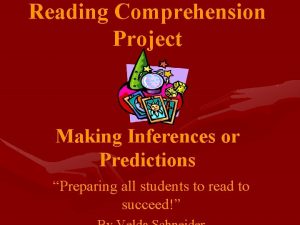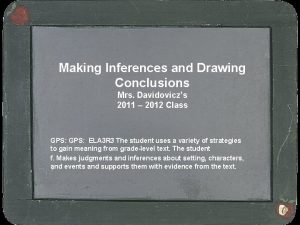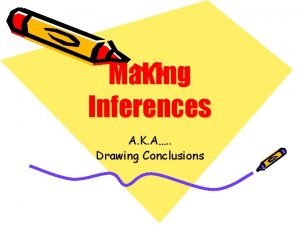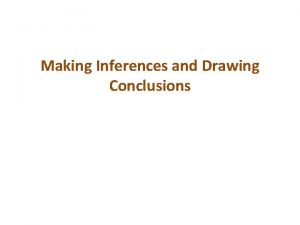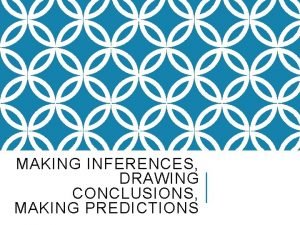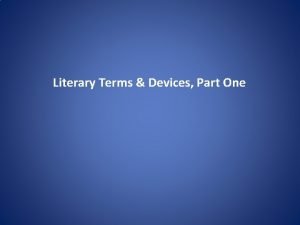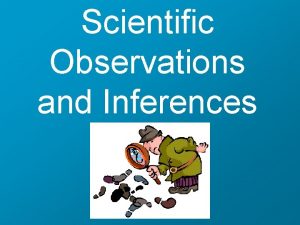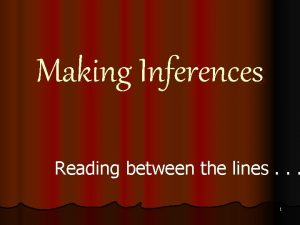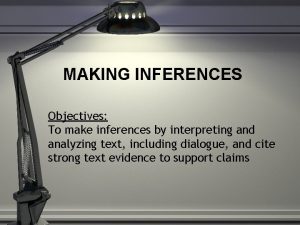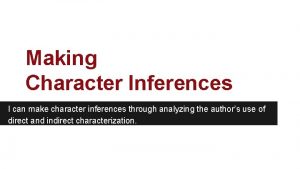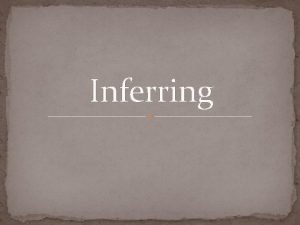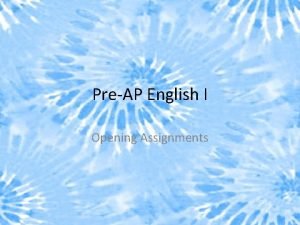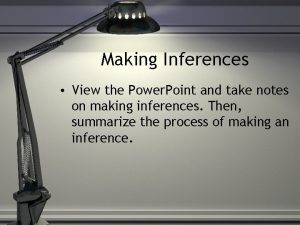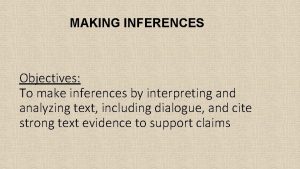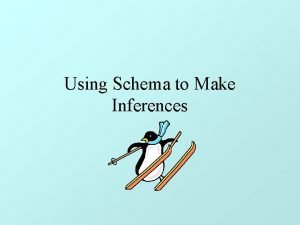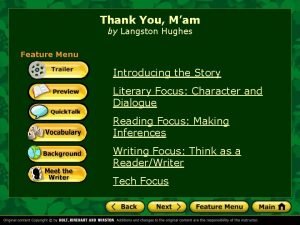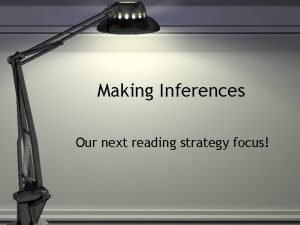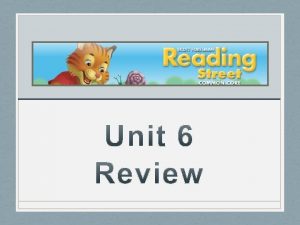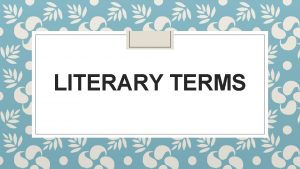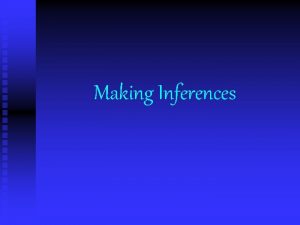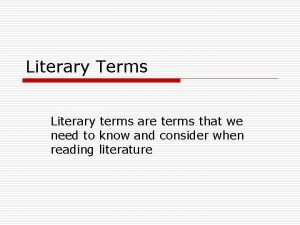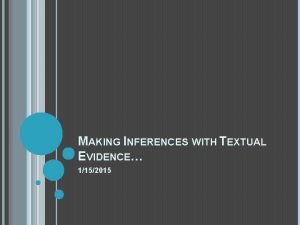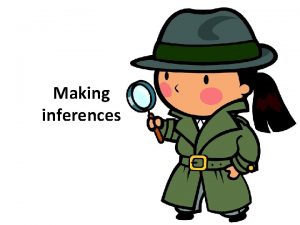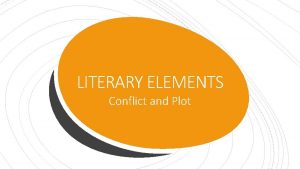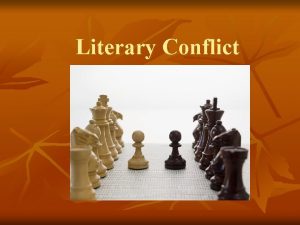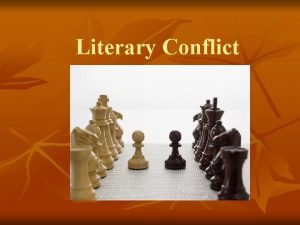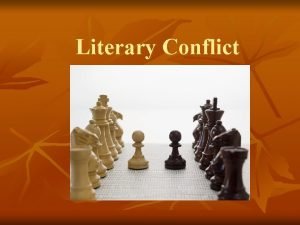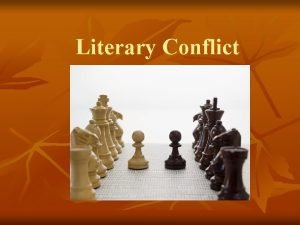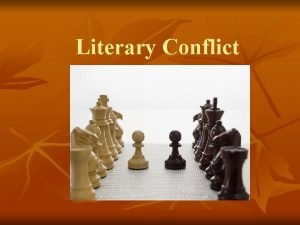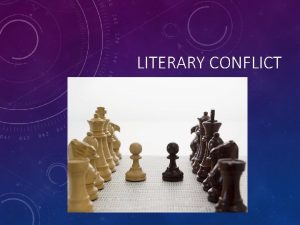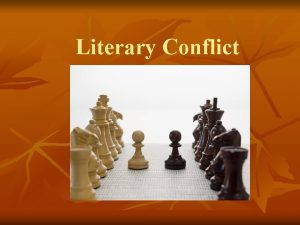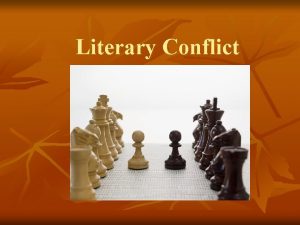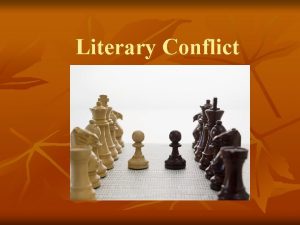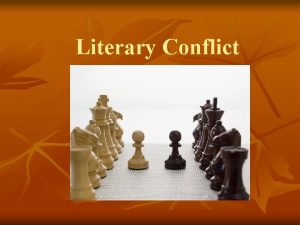LITERARY TERMS Conflict and making Inferences p 211






















- Slides: 22

LITERARY TERMS • • • • Conflict and making Inferences p. 211 Elements of short stories pp. 198 -199 Irony and making Inferences p. 267 Characterization p. 313 Cause and effect p. 313 Point of view p. 80 Character types p. 125 Plot pyramid p. 43 Point of View p. 80 Character & Author's Purpose p. 125 Voice p. 101 Symbols & Allegories p. 324 Mood Sound Devices Literary Imagery Tone

Literary Analysis: Conflict is a struggle between opposing forces. • In an external conflict, a character clashes with an outside force—for example, another character, society, or nature. • In an internal conflict, a character grapples with his or her own opposing feelings, beliefs, needs, or desires. Conflict drives the plot of most stories. Its solution usually occurs near the end of the story, in the resolution. When a story’s conflict is left unresolved, the character may have an epiphany, or sudden flash of insight that changes his or her feelings about the conflict. Some epiphanies can also lead to a plot’s resolution, or result from one. As you read, notice the conflicts that characters face and decide which ones truly are resolved. Copyright © 2010 by Pearson Education, Inc, or its affiliates. All rights reserved.

Reading Skill: Make Inferences are logical assumptions about information or ideas that are not directly stated in a piece of writing. When you make inferences, you use details as clues to develop ideas about unstated information and concepts in a text. To make inferences as you read a story, for example, ask questions such as these about characters’ feelings and behavior: • What does this detail show about the reasons for a character’s actions or words? • What does this passage say about the character’s unstated feelings? Using the Strategy: Inferences Chart Use an inferences chart like this one to track your thinking as you read. Detail Question Inference The door was painted green, the color of hope. Why might a writer describe a door as having the color of an emotion? The door stands for opportunity. Copyright © 2010 by Pearson Education, Inc, or its affiliates. All rights reserved.

The Gift of the Magi • The Interlopers Literary Analysis: Irony is a contradiction between appearance and reality—it is the difference between what is expected and what actually happens. In situational irony, something happens in the story that contradicts the expectations of a character or the reader. For example, a runner who trains hard would be expected to do well in a race. It would be ironic if she trained so hard that she overslept and missed the race. A surprise ending often presents a situational irony. The turn of events may be startling, but writers using irony usually build clues into the story that make the ending logical, just the same.

The Gift of the Magi Literary Analysis: Irony 1. (a) Identify irony in the story by using a chart like the one shown. In the first box, note the outcome that Jim and Della expect when they present their gifts to each other. In the second box, describe what actually happens. What Characters Expect What Actually Happens (b) Explain the role of irony in this literary work. 2. (a) Which details in the story make its surprise ending seem like a logical outcome of events? (b) Why do you think surprise endings are such a popular device in literature and movies?

Rules of the Game • The Necklace Reading Skill: Cause and Effect A cause is an event, action, or feeling that produces a result. An effect is the result produced. A single cause may produce several effects. For example, a poor student starts to do well in school. Her success results in greater self-esteem. Effects, in turn, may become causes. For example, that same student’s new confidence leads her to audition for a play. Reflect on your understanding to monitor your comprehension of the story events.

Reading Skill: Cause and Effect cont. Jot down your answers to the following questions to make connections between causes and effects in the text. • What happened? • Why did it happen? • What happens as a result? • Does that result cause something else to happen?

Literary Analysis: Character A character is a person or an animal who takes part in the action of a literary work. • A round character is complex, showing many different qualities —revealing faults as well as virtues. For example, a character might be honest but foolish or dishonest but intelligent. A flat character is one-dimensional, showing only a single trait. • A dynamic character develops, changes, and learns something during the course of a story, unlike a static character, who remains the same. The main character of a story is almost always a round character and is usually dynamic. The main character’s development and growth are often central to a story’s plot and theme. As you read, consider the traits that make characters seem round or flat, dynamic or static.

Warm up: On a separate piece of paper make a plot pyramid. Label the parts. Literary Analysis: Plot is the sequence of events in a narrative. It is structured around a conflict, or problem, and it can be divided into the following parts: • Exposition: characters and setting are introduced • Rising Action: central conflict begins • Climax: high point of intensity in the conflict is reached • Falling Action: conflict’s intensity lessens • Resolution: conflict concludes and loose ends are tied up Writers use a variety of techniques, or stylistic devices, to keep readers interested in the plot. One of these devices, foreshadowing, is the use of clues to hint at events that will happen later in a story. Authors use this technique to create suspense, a feeling of tension that keeps readers wondering what will happen next.

The Secret Life of Walter Mitty • Uncle Marcos Literary Analysis: Character A character is a person or an animal who takes part in the action of a literary work. Author’s develop complex yet believable characters in works of fiction through a range of literary devices and strategies. You can learn about a character through the character’s words and actions, the author’s narration, and what others say about the character. • A round character is complex, showing many different qualities—revealing faults as well as virtues. In contrast, a flat character is one-dimensional, showing a single trait. • A dynamic character develops, changes, and learns something during the course of a story—unlike a static character, who remains the same.

Reading Skill: Author’s Purpose An author’s purpose is his or her main reason for writing. An author can write for a general purpose, such as to inform, to entertain, or to persuade. He or she may also write for a specific purpose, such as to expose a particular problem in society. To get the most out of what you read, preview the text before you read to look for an author’s purpose. • Notice information or ideas conveyed in the title. • Look for any organizing features, such as subheads. • Identify the subject of photos, illustrations, or diagrams.

The Secret Life of Walter Mitty • Uncle Marcos Reading Skill: Author’s Purpose An author’s purpose is his or her main reason for writing. In fiction, the specific purpose is often conveyed by the story’s theme. Pause periodically while reading and reflect on your understanding. Ask questions to make inferences about the story’s details and events. Use the following questions as models: • What significance might this event have? • Why does the author include this detail? Use the inferences you have made to determine the author’s purpose.

Point of view is the perspective from which a story is narrated, or told. First-person point of view: The narrator is a character who participates in the action and uses the first-person pronouns I and me. Third-person point of view: The narrator is not a character in the story but a voice outside it. The narrator uses the third-person pronouns he, she, him, her, they, and them to refer to all characters. There are two kinds of third-person point of view. In the third-person omniscient point of view, the narrator knows everything, including the thoughts of all the characters. In the third-person limited point of view, the narrator sees and reports things through one character’s eyes. These selections are written using different points of view. As you read, complete a Venn diagram like this one to compare and contrast how the point of view affects the way you understand the characters and the plot of each story.

Using the Strategy: Author’s Purpose Map Use a chart like the one shown to reflect on your understanding. Record your questions and inferences about story details and events. Then, identify the author’s purpose based on your findings. Story Event or Detail Possible Significance Author’s Purpose?

Literary Analysis: Symbolism and Allegory A symbol is a person, a place, a thing, or an event that represents both itself and a larger idea or feeling. Symbolism is the use of symbols in literature. For example, a writer might use a journey as a symbol for the life of a human being. An allegory is a poem or story that has parallel literal and symbolic meanings. On the literal level, the story appears simply as it is told. On the symbolic level, however, every element in the story—including the characters, events, descriptions, and features of the setting—has a symbolic meaning. While an allegory can be understood on the literal level, its full meaning is clear only on the symbolic level. Often, allegories may seem less realistic than nonallegorical works, and they may shed light on current events.

from A White House Diary • My English Literary Analysis: Voice is the way a writer sounds on the page. For example, the writer’s voice in a work can be smooth and sophisticated, choppy and blunt, or breathless and full of wonder. Voice is a result of several elements: • Word choice: the kinds of words the writer uses • Attitude: the way the writer feels about his or her subject • Sentence structure: the arrangement of words in sentences In autobiographical writing, the author tells all or part of his or her own life story. The details the author includes show what he or she notices, thinks, and feels about events.

• Literary Analysis: Symbolism and Allegory • A symbol is a person, a place, a thing, or an event that represents both itself and a larger idea or feeling. Symbolism is the use of symbols in literature. For example, a writer might use a journey as a symbol for the life of a human being. • An allegory is a poem or story that has parallel literal and symbolic meanings. On the literal level, the story appears simply as it is told. On the symbolic level, however, every element in the story—including the characters, events, descriptions, and features of the setting—has a symbolic meaning. While an allegory can be understood on the literal level, its full meaning is clear only on the symbolic level. Often, allegories may seem less realistic than nonallegorical works, and they may shed light on current events. •

Mood or atmosphere, is the feeling created in the reader by a literary work or passage. The mood is often suggested by descriptive details. Can often be described in a single word.

Poetry Collections 3 and 4 Literary Analysis: Sound Devices An important element of poetry is the sound of the words the author uses. Poets use sound devices to emphasize the sound relationships among words, which often bring fluidity and meaning to a text. These include: • Alliteration: the repetition of initial consonant sounds in stressed syllables: “The fair breeze blew, the white foam flew. . . ” • Consonance: the repetition of final consonant sounds in stressed syllables with different vowel sounds, as in sit and cat • Assonance: the repetition of similar vowel sounds in stressed syllables that end with different consonants, as in seal and meet • Onomatopoeia: the use of a word whose sound imitates its meaning, such as pop or hiss

Poetry Collections 1 and 2 Literary Analysis: Figurative Language Figurative language is language that is used imaginatively rather than literally, which can significantly impact the tone, mood, and theme of a poem. Figurative language includes one or more figures of speech, literary devices that make unexpected comparisons or change the usual meaning of words. The following are specific types of figures of speech: • Simile: a comparison of two apparently unlike things using like, as, than, or resembles: “The morning sun is like a red rubber ball. ” • Metaphor: a description of one thing as if it were another: “The morning sun is a red rubber ball. ” • Personification: assignment of human characteristics to a nonhuman subject: “The sea was angry that day, my friends. ” • Paradox: a statement, an idea, or a situation that seems contradictory but actually expresses a truth: “The more things change, the more they stay the same. ”

• Dear Ms. Kemp, • I am abashed to inform you that my capricious dog had the audacity to eat my homework thinking it was poorly done. • It is with great fear of your austere presence that I desire to circumvent your disdainful reproach for my atrociously, paltry behavior.

TONE • Tone is a writer’s attitude toward his or her audience & subject. (Ex: formal, serious, playful, sarcastic)
 Making inferences and predictions
Making inferences and predictions Drawing conclusions and making inferences powerpoint
Drawing conclusions and making inferences powerpoint Example of making inferences and drawing conclusions
Example of making inferences and drawing conclusions When drawing conclusions, make sure you
When drawing conclusions, make sure you Making inferences and drawing conclusions
Making inferences and drawing conclusions Define literary conflict
Define literary conflict Making inferences in science
Making inferences in science Making inferences is reading between the lines.
Making inferences is reading between the lines. Making inferences objectives
Making inferences objectives By making inferences based on analysis of a character
By making inferences based on analysis of a character Inference charades
Inference charades Making inferences examples
Making inferences examples Making inferences
Making inferences Making inferences powerpoint
Making inferences powerpoint Inference objectives
Inference objectives Essential questions for inferencing
Essential questions for inferencing Making inferences with dialogue thank you ma'am
Making inferences with dialogue thank you ma'am Making inferences reading strategy
Making inferences reading strategy Brainpop making inferences
Brainpop making inferences Polynomial classification
Polynomial classification Identify the terms and like terms in the expression. t+8+3t
Identify the terms and like terms in the expression. t+8+3t War making and state making as organized crime
War making and state making as organized crime Internal conflict vs external conflict
Internal conflict vs external conflict
